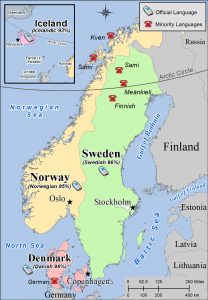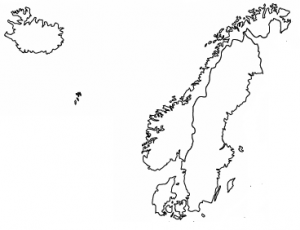49 Europe: Regional Example – Scandinavia
“Det är ingen ko på isen.” – Old Swedish proverb.
– “There is no cow on the ice.” Meaning – Don’t worry.
Regional geography studies the people and places of a cohesive region. A “region” is defined to be an area with multiple shared characteristics over a range of categories, including both physical and human geographic characteristics. The secret of creating a region, which is a human construct not a naturally begotten unit, is to cluster together as many similarities as possible, while excluding geographic differences.
In Europe, Scandinavia is one of the sub-regions. Its definition also follows the methodology of regional geography. It turns out that this is a complicated question.
Ideally, Scandinavia is a region defined by ethnicity and language, key elements of Cultural Geography. If so, then Scandinavia is not simply the same as Northern Europe or the Nordic countries, while it is related somewhat by location or proximity.
In terms of shared language patterns and roots in the northern part of Europe, only four countries are linked – Iceland, Denmark, Sweden, and Norway – as shown in outline maps from top to bottom in this chapter. In the Indo-European language family, there are dozens of languages. Some are languages currently spoken by millions of people, some by only hundreds of people. Some are dead languages. One branch of the tree of languages goes like this – Indo-European » Germanic » Old Norse » Danish, Icelandic, Norwegian, Swedish, and Faroese. (Faroese is spoken primarily on the Faroe Islands, an autonomous territory of Denmark. The Faroe Islands could be listed as an additional piece of Scandinavia or its inclusion could be assumed as part of Denmark. Greenland too is an autonomous territory of Denmark. Both the Faroe Islands and Greenland will be assumed as part of Denmark in this essay.)

Cartography by Steve Wiertz.
The very much smaller and entirely separate Uralic language family has only a few languages in it. The Uralic family includes the Finno-Ugric family plus Samoyedic languages of some of the numerically small peoples of Siberia. The Finno-Ugric family contains Finnish, Estonian, Hungarian, and scattered languages such as Sami.
Thus, the Indo-European and Uralic language families are mutually exclusive. Norwegians cannot naturally understand Finnish language, but must learn it as an entirely unrelated language. Estonians cannot naturally understand Danish, but must learn it as an entirely unrelated language. Since a shared or similar language is a core element of any geographic region, in northern parts of Europe this language mismatch among these peoples works against including Finland and Estonia in Scandinavia.
Historically, there are very significant links between Norway, Sweden, Denmark, and Iceland. For most of the years from 1397 to 1523, these joined together in the Kalmar Union, joint governance under a single ruler. Denmark and Norway were together from 1537 to 1814., Sweden and Norway 1814-1905. It is true that Finland was considered part of the Swedish realm until 1809, but then Finland was taken by Russia, thus further distant culturally from Scandinavia.
The term Norseman historically refers to those from Norway, Sweden, and Denmark. Attacking Norseman, also known as Vikings, raided and expanded into Europe. These Vikings also explored westward, reaching Iceland, Greenland, and Vinland (North America), thus extended their language and culture in that direction.
In terms of physical geography, Scandinavia can refer to the same named peninsula. This clearly includes Norway and Sweden, but what part of Finland is there remains vague. The Scandinavian Mountains (or Scandinavian Highlands) extend along the shared border of Norway and Sweden, perhaps touching Finland at the margins.
It seems best to assert that Finland is in Northern Europe, but not in Scandinavia. From Finland, Estonia sits a short distance across the Gulf of Finland. Because Estonians are closely related to Finns and because Estonia for over a quarter century has been independent of the former Soviet Union, Estonia now should be counted as part of Northern Europe as well, not in Eastern Europe.

Arguably, the linguistic, historical, and physical patterns of these northern sections of Europe best place Norway, Sweden, Denmark, and Iceland together as the sub-region known as Scandinavia. Add Finland and Estonia to this set of countries to delineate the region of Northern Europe. The Nordic countries would be another term for Northern Europe. For an excellent map of Scandinavian dialects, go to this website: https://tinyurl.com/scanddialects
Part of the fun of Geography is the challenge of making pieces of the world fit together as regions, thereby allowing people to view the world in cohesive ways.
Did You Know?
Norway has more land than pictured above. Svalbard is a set of islands that lies much farther north than the northern edge of continental Norway. Perhaps we should show it.
Recall from Chapter 23 that New Zealand has physical landscape features like those of Iceland and Norway. Watch for this in the Chapter 58 about Iceland. Right here, watch this video for a look at a fjord in Norway. Video by Frederik M on Pexels (no audio).
Cited and additional bibliography:
M, Frederik. 2020. “Fjord in Norway.” https://www.pexels.com/video/drone-footage-of-a-river-valley-5208612/.
Scandinavian Dialects. 2009. https://www.geocurrents.info/cultural-geography/linguistic-geography/103-errors-in-mapping-indo-european-languages-in-bouckaert-et-al-part-iv-central-europe/attachment/scandinavian-dialects-map.
Wiertz, Steve. 2020. “Languages in Scandinavia.” College of DuPage GIS class. Instructor Joseph Adduci.





